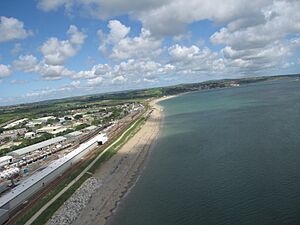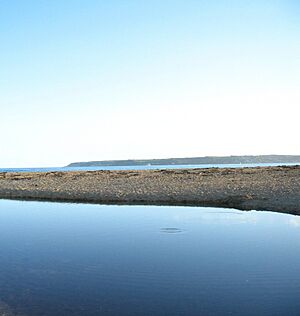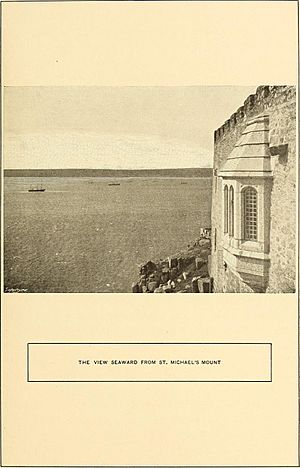Mount's Bay facts for kids
Mount's Bay (Cornish: Baya an Garrek) is a big, curved bay on the English Channel coast of Cornwall, United Kingdom. It stretches from Lizard Point to Gwennap Head.
In the northern part of the bay, near Marazion, you'll find St Michael's Mount. This famous island is where the bay gets its name!
During summer, Mount's Bay is a beautiful and safe natural harbour. But in winter, strong winds from the sea can make it dangerous for ships. More than 150 ships are known to have wrecked here in the 1800s.
The eastern side of the bay, around Marazion and St Michael's Mount, became a special protected area called a Marine Conservation Zone in 2016. This helps protect the sea life there.
Contents
Exploring Mount's Bay: Land and Sea
Mount's Bay is the largest bay in Cornwall. It has a half-moon shape, a bit like other bays in Ireland and Wales. Even though it's big, it's quite protected from the strong winds that blow across the Atlantic Ocean. However, very strong winds from the south or southeast can still make it risky for ships.
The coastline of the bay is about 42 kilometres long. As you travel along the coast, you'll see different types of cliffs and beaches. Some cliffs are very tall, like at Vellan Head, while others are lower and more easily worn away by the sea.
You'll find sandy beaches at places like Praa Sands and Kenneggy. These beaches are slowly shrinking as the cliffs behind them wear away. The area around Penzance, Marazion, Newlyn, and Mousehole is the most populated part of the bay.
There are also small areas of sand dunes at places like Church Cove and Poldhu Cove. These dunes form in sheltered spots between rocky headlands.
Clues from the Past: Old Sea Levels
You can see signs that the sea level used to be higher in the past. For example, the town of Marazion is built on what was once a raised beach. This shows us where the sea used to reach during warmer periods when ice sheets melted.
If you visit the beaches near Penzance, like Ponsandane and Wherrytown, you might see something amazing at low tide: parts of a 'submerged forest'! These are fossilized tree trunks that show a forest once grew where the sea is now.
Life After the Ice Age
Scientists have explored the seabed and found signs of ancient wetlands and forests that were covered by the sea as water levels rose after the last Ice age. About 6,000 years ago, the sea reached its current level.
The 'submerged forest' near Penzance is a great example of this. Trees grew there from at least 6,000 to about 4,000 years ago. As the sea rose, it eventually killed the trees. People lived in this area during the Mesolithic period (a very long time ago!), so they would have seen this forest.
Sometimes, big storms would break through natural sand barriers, covering old peat beds with sand and gravel. You can still see parts of these old barriers today. The submerged forest is very important for understanding the geology of Cornwall.
Mount's Bay Marine Conservation Zone
The Mount's Bay Marine Conservation Zone (MCZ) was created in 2016. It covers about 12 square kilometres of the bay, including the waters around St Michael's Mount.
This special zone protects different types of sea habitats, from rocky shores to sandy seabeds. One important habitat is the seagrass beds, especially Zostera marina. These seagrass beds are like underwater nurseries for young fish and shellfish, and they are also feeding grounds for birds. It's important to protect them from damage, for example, from boat anchors.
Animals living in this zone include special types of stalked jellyfish and the giant goby fish. In 2018, a rare white harbour porpoise was even spotted near Mount's Bay!
Mount's Bay Through History
Mount's Bay has seen many interesting events over the centuries.
Spanish Attack of 1595
During a war between England and Spain (1585–1604), a Spanish group attacked Mount's Bay in August 1595. They landed and burned down the towns of Newlyn, Mousehole, Penzance, and Paul. Even a local army couldn't stop them.
Pirate Attacks
In August 1625, pirates from North Africa, sometimes called "Turks," attacked a church in Mount's Bay. They captured about sixty men, women, and children and took them away as slaves. These Barbary Pirates were known for raiding European coasts and taking many people to slave markets.
The 1755 Tsunami
On November 1, 1755, a huge earthquake happened in Lisbon, Portugal. This caused a giant wave, called a tsunami, to hit the Cornish coast around 2 PM. At Mount's Bay, the sea quickly rose about 3 metres and then went back out just as fast.
Towns and Villages of Mount's Bay
Many towns and villages are located around Mount's Bay. The biggest town is Penzance.
- To the west of Penzance, you'll find Newlyn, Paul, Mousehole, and Lamorna.
- To the east, there's Marazion, Perranuthnoe, Praa Sands, Porthleven, and Mullion.
The bay also has many beautiful beaches, coves, and interesting places like Prussia Cove, Loe Pool (and Loe Bar), Church Cove, Poldhu Cove, and Kynance Cove.
In the churchyard of St. Paul Aurelian in Paul, there's a monument to Dolly Pentreath. She is traditionally known as the last person to speak the Cornish language as her first language.
Mount's Bay also gives its name to a local secondary school, Mounts Bay Academy, which is in Heamoor and serves the Penzance area.
Mining in Mount's Bay
For a long time, people mined for valuable metals along the shore of Mount's Bay. Some mines were even built right into the sea!
One famous mine was on the Wherrytown reef. People believed there were rich veins of tin there. In the late 1700s, a man named Thomas Curtis built a wooden tower with a stone wall to mine tin from the reef. This mine produced a lot of tin, but it was eventually destroyed by a storm in 1798. Later attempts to reopen it didn't succeed.
Another reef, called Long Rock reef, also produced tin in the early 1800s. It also had other metals like antimony, copper, and silver.
The RFA Mount's Bay is a modern ship used by the Royal Navy. It's a Landing Ship Dock, which means it's designed to carry troops and equipment and land them on shore. It was built in 2006 and is part of the Bay Class of ships.
Images for kids







